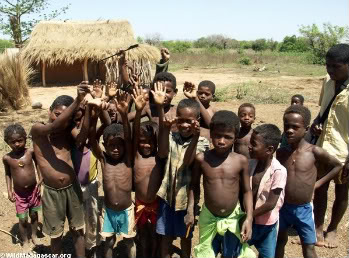Despite declining birth rates in some developed countries, the world population is still growing—and fast. A new study by the Population Reference Bureau (PRB) finds that the human population will hit a new milestone of seven billion people by 2011.
The number will be reached just twelve years after the planet hit 6 billion people in 1999.
“Even with declining fertility rates in many countries, world population is still growing at a rapid rate,” said Bill Butz, PRB’s president. “The increase from 6 billion to 7 billion is likely to take 12 years, as did the increase from 5 billion to 6 billion. Both events are unprecedented in world history.”
 Children in Madagascar. Half of the children under five in Madagascar are malnourished and two-thirds of the population live on less than 1.25 dollars US a day. Photo by: Rhett A. Butler. |
Population growth is being driven almost entirely by developing countries. In fact, the human population of Africa has just passed one billion and if birth rates remain steady the continent will reach two billion by 2050. Countries in Africa, and other parts of the developed world, are also seeing a youth boom (ages 15-24).
“The great bulk of today’s 1.2 billion youth—nearly 90 percent—are in developing countries,” said Carl Haub, PRB senior demographer and co-author of the data sheet. “During the next few decades, these young people will most likely continue the current trend of moving from rural areas to cities in search of education and training opportunities, gainful employment, and adequate health care.”
But will these young people—of which 8 out of 10 are in Africa and Asia—find what they are looking for?
Despite decades of work on abolishing poverty, half of the world’s people still live in below the poverty line, surviving on less than 2 dollars US a day.
According to estimates, world population has been growing consistently since after the Black Death swept Europe and Asia in the 14th Century. At that time global population has been estimated at 350 million people. By 2011, there will be twenty times that number on Earth.
Related articles
Meeting food and energy demands by mid-century will be a challenge, says report
(06/25/2009) Meeting food and energy demands in a world where human population is expected to reach 9 billion by mid-century will require a range of approaches that increase the sustainability of agricultural production, reports a new assessment from Deutsche Bank’s Climate Change Advisors (DBCCA).
Record hunger: one billion people are going hungry worldwide
(06/22/2009) A new estimate by the UN FAO estimates that one billion people are currently going hungry: the highest number in history. Largely exacerbated by the global economic crisis, the number of the world’s hungry has risen by 100 million people.
UN: Population growth rates fall to 1.1 percent in Asia-Pacific
(05/19/2009) The population growth rate in the Asia-Pacific region has dropped to 1.1 percent, according to the Statistical Yearbook for Asia and the Pacific 2008, compiled by the UN’s Economic and Social Commission for Asia and the Pacific (ESCAP). The 1.1 percent growth rate is the lowest in the developing world.
Group devoted to cutting human population receives boost from David Attenborough
(04/13/2009) Legendary filmmaker, broadcaster, and conservationist, David Attenborough has become a patron of the group Optimum Population Trust (OPT). The organization’s goal is to use education and policy to lower the world’s population.
Sustainable farming is the only way to feed the planet going forward
(02/05/2009) Embracing more sustainable farming methods is the only way for the world’s farmers to grow enough food to meet the demands of a growing population and respond to climate change, the top crop expert with the United Nations Food and Agriculture Organization (FAO) said today.














